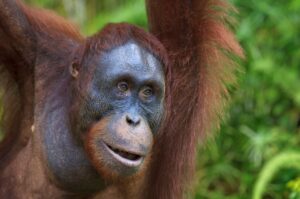A passion for the natural world drives many of our adventures. And when we’re not actually outside, we love delving into the discoveries about the places where we live and travel. Here are some of the best natural history links we’ve found this week.
Genetic study reveals how ancient seafarers settled Polynesia: The islands of Polynesia were the last habitable region to be settled by humans. New genetic research has revealed how and when the migrants settled. They moved to Samoa first and Rapa Nui — commonly known as Easter Island — last or almost last. From Samoa, they spread to Fiji, Tonga, and Rarotonga in the 9th century. Much later, in the 13th century, they continued to Rapa Nui and Raivavae.
Glow-in-the-dark gophers
Pocket gophers glow in the dark: Ultraviolet biofluorescence is widespread in fish, amphibians, birds, and plants. It is far less common among mammals. We can now add pocket gophers to the shortlist of glow-in-the-dark mammals. Researchers tested four species of these gophers. Under UV light, all individuals’ abdomens fluoresced bright orange pink. Their backs were slightly duller. Some also glowed blue around their mouths.

Pocket gophers glow in the dark. Photo: Pynne et al
Climate change threatens the polar ocean’s food web: Polar oceans host some of the largest food webs on earth. The base of the marine food web is microscopic phytoplankton. In colder water, the phytoplankton are eukaryotic, which means that their cells have a distinct nucleus. As water temperatures rise, the prokaryotic phytoplankton (without nuclei) that occur in warmer waters could replace them. “Prokaryotes are not capable of producing all the juicy proteins and lipids that eukaryotes can,” says marine microbiologist Thomas Mock. This would have huge consequences for the entire arctic food web.
‘Ghost tracks’ suggest people came to the Americas earlier than believed: Over 60 footprints found in New Mexico have been dated between 23,000 and 21,000 years ago. If the fossil findings are correct, it proves that humans walked through North America during the last Ice Age –- earlier than previously thought. Scientists calculated the age of the footprints by radiocarbon dating the aquatic plants ingrained into the prints. Still, some archaeologists aren’t convinced. They want the dating double-checked in other ways. “This is the kind of stuff that makes you rewrite textbooks,” said Loren Davis, Oregon State University. “For the good of the field, we need really high standards.”

These human footprints from present-day New Mexico may be between 23,000 and 21,000 years old. Photo: David Bustos/Bournemouth University
The Goldilocks principle works for pandas
Too much of a good home is bad for panda mating: Experts think the Goldilocks principle can be applied to creating habitats for giant pandas. The vulnerable species thrives and reproduces most effectively when its habitat is “just right”. This occurs when 80 percent of its habitat is ideal. If the ideal environment exceeds this, the bears spread out too much. Then their reproductive success declines rapidly.

Juvenile giant panda. Photo: Shutterstock
Vampire bats prefer to drink with friends: Vampire bats that have bonded while roosting and grooming often team up to drink blood. Researchers studied a colony’s social network using tiny bat backpacks housing computer sensors on 50 female bats. The bats rarely left the roost together and mostly foraged alone, but if they bumped into a roost buddy while hunting, they fed together. By contrast, when the bats met a feeding stranger, a fight was the most common outcome.
Personality matters, even for squirrels: It is not as easy for a scientist to talk about an animal’s personality as it is for a pet owner. But a new study is the first to document personality in golden-mantled ground squirrels. They displayed four main personality traits; boldness, aggressiveness, activity level, and sociability. Different traits gave the squirrels different advantages. Bolder ones had larger core areas. Those that were more aggressive or social had greater access to perches.





